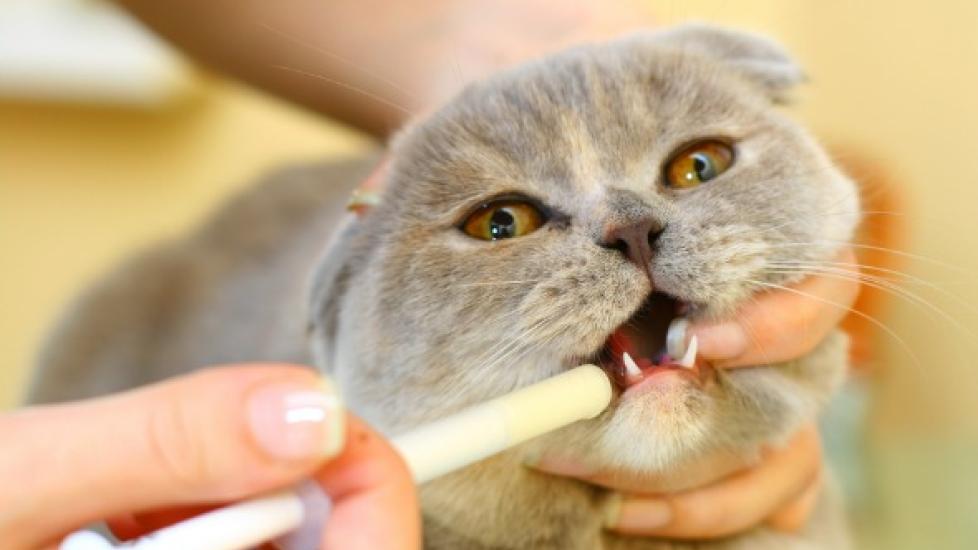Best Ways to Give Your Cat Medicine
Medicating a cat is sometimes one of the most challenging tasks a cat owner must face. But with a little advance preparation, it doesn’t have to be difficult.
Before you attempt to medicate your cat, get all your supplies together. Have the medication handy, along with a treat to make the experience more pleasant for your cat, and a towel for wrapping your cat if necessary.
To give a liquid medication, place your cat on a flat surface, facing away from you with his hindquarters against your body. You should already have the medication drawn up into a dosing syringe. Use your free hand to tilt your cat’s head up slightly. Place the tip of syringe in the back corner of your cat’s mouth, squirting the medication in the space between the cheek and gums. Be sure to reward your cat with a favorite treat afterward.
To give a pill or capsule, hold your cat in the same position you would to give a liquid. Using one hand, steady your cat’s head and tilt it slightly upward. Grasp the pill or capsule between your thumb and forefinger of the opposite hand. Use your middle finger to open your cat’s mouth and slide the pill down the center of the tongue to the back of the mouth, getting the pill as far back into their mouth as possible. It may also be helpful for less cooperative cats, to firmly hold your cat’s scruff while administering the pill.
Alternatively, you can use a pill gun or pill popper (a device used to hold the pill or capsule and place it in the mouth), again placing the medication on the tongue at the back of your cat’s mouth. Continue to hold your cat’s head in a slightly tilted position with the mouth closed until you see your cat swallow. Follow the pilling procedure with a treat for your cat.
If your cat struggles and attempts to scratch, wrap a thick towel around your cat’s neck and front legs to protect yourself from your cat’s claws.
If medicating your cat is difficult, you may try hiding your cat’s medication in food. Liquid medication can be mixed in with wet food or with gravy or tuna juice. Check with your veterinarian first though, to be sure that this will not affect the efficacy of the medication.
For pills or capsules, you can purchase pill pockets which can be used to hide a pill or capsule inside. The pill pocket with the medication inside is then offered as a treat. Alternatively, you can try making your own pill pocket by wrapping the pill or capsule in a bit of cheese or inside of a ball of canned food. However, many cats will simply nibble around the medication, rather than actually taking the medication. If your cat does this, you will need to either manually medicate your cat or find another alternative.
In many situations, there may be other alternatives available. Many medications can be compounded, producing a liquid with a pleasant flavor. This allows cats that are either unwilling or unable to take medication other ways, to still get their medication. There are special compounding pharmacies that can do this if your veterinarian is unable to formulate the flavored medication in the hospital.
Some medications are also available as a transdermal gel, or can be compounded into one. This special medicated gel is able to be absorbed through the skin rather than requiring oral administration. Typically, these medications are applied to the inside of the tip of the ear. Methimazole, a medication frequently used to treat hyperthyroidism in cats, is frequently dosed as a transdermal gel.
Transdermal patches are another alternative that may be an option with some medications. These are patches with medication embedded in them that are affixed directly to the skin. The medication is then released from the patch through the skin in a time-released manner. Fentanyl, a potent pain reliever, is often dosed as a patch.
Unfortunately, not all medications lend themselves well to transdermal applications. However, your veterinarian will be able to help you choose a medication delivery system that is manageable for you and can also demonstrate how to go about medicating your cat.
Have you found a tip that is useful in medicating your cat? Please share it with us in the comments.

Dr. Lorie Huston
Last reviewed on July 24, 2015
